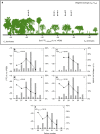Earliest Olduvai hominins exploited unstable environments ~ 2 million years ago
- PMID: 33414467
- PMCID: PMC7791053
- DOI: 10.1038/s41467-020-20176-2
Earliest Olduvai hominins exploited unstable environments ~ 2 million years ago
Abstract
Rapid environmental change is a catalyst for human evolution, driving dietary innovations, habitat diversification, and dispersal. However, there is a dearth of information to assess hominin adaptions to changing physiography during key evolutionary stages such as the early Pleistocene. Here we report a multiproxy dataset from Ewass Oldupa, in the Western Plio-Pleistocene rift basin of Olduvai Gorge (now Oldupai), Tanzania, to address this lacuna and offer an ecological perspective on human adaptability two million years ago. Oldupai's earliest hominins sequentially inhabited the floodplains of sinuous channels, then river-influenced contexts, which now comprises the oldest palaeolake setting documented regionally. Early Oldowan tools reveal a homogenous technology to utilise diverse, rapidly changing environments that ranged from fern meadows to woodland mosaics, naturally burned landscapes, to lakeside woodland/palm groves as well as hyper-xeric steppes. Hominins periodically used emerging landscapes and disturbance biomes multiple times over 235,000 years, thus predating by more than 180,000 years the earliest known hominins and Oldowan industries from the Eastern side of the basin.
Conflict of interest statement
The authors declare no competing interests.
Figures








References
-
- Toth N, Schick K. An overview of the cognitive implications of the Oldowan Industrial Complex. Azania. 2018;53:3–39. doi: 10.1080/0067270X.2018.1439558. - DOI
Publication types
MeSH terms
Substances
LinkOut - more resources
Full Text Sources
Other Literature Sources

